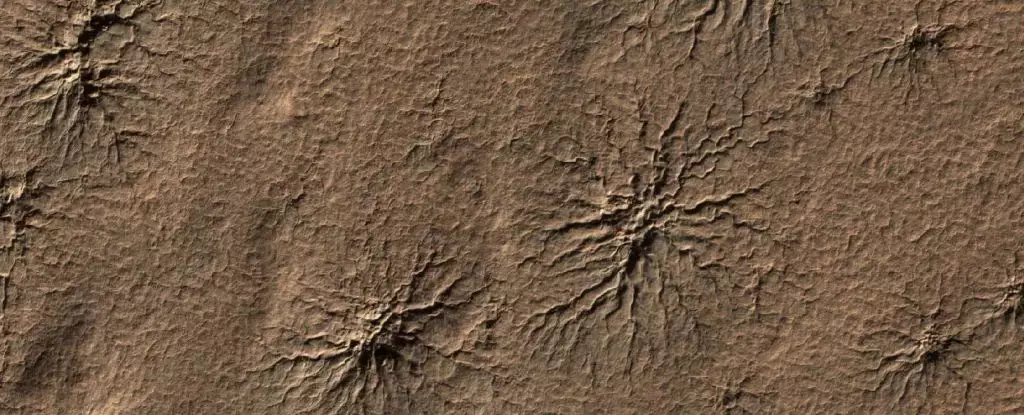Mars, often romanticized as the “Red Planet,” harbors a myriad of secrets beneath its rust-colored surface. Among these enigmas are peculiar formations known as araneiforms, which resemble elongated spider-like mounds. While many might picture actual arachnids scuttling across the Martian landscape, these so-called “spiders” are, in fact, intriguing geological features shaped by the planet’s unique environmental conditions. To truly grasp the ins and outs of these phenomena, one must delve into the processes that lead to their formation and what these structures reveal about the climate of Mars.
Araneiforms can be observed primarily in the southern polar region of Mars during the planet’s spring cycle. Appearing as intricate patterns etched into the surface, they are formed from dark troughs that emerge from beneath layers of frost. The sight of these formations captivates scientists and laypeople alike, drawing interest comparable to some of Earth’s natural wonders. However, what sets Martian araneiforms apart is not just their aesthetic appeal but the scientific insights they provide into the planet’s atmospheric conditions.
The notion that these, at first glance, organic-looking shapes may merely be geological formations challenges our understanding of extraterrestrial surfaces. What we perceive as “spiders” is nothing but the result of complex interactions between the environment, the Martian regolith, and frozen carbon dioxide. Analyzing such structures not only tells us about Mars but also allows scientists to refine their models of planetary geology, particularly in extreme conditions.
In 2006 and 2007, geophysicist Hugh Kieffer put forth a revolutionary model explaining how araneiforms come into existence. According to the Kieffer model, carbon dioxide, which behaves differently in the cold Martian climate than it does on Earth, freezes directly onto the surface during the harsh winters. As spring arrives, the sublimation process transforms these icy deposits back into gaseous form. This transition does not happen gently; rather, it builds pressure from underneath the icy layer, leading to explosive ruptures that propel dust outwards, leaving behind those notorious spider-like scars.
What makes this model particularly fascinating is its divergence from terrestrial processes. Unlike Earth, where carbon dioxide can exist as a liquid under specific conditions, Mars enlistes a cycle wherein solid carbon dioxide sublimates directly into gas. Thus, these araneiform patterns are not just unique but highlight a stark contrast between the planetary environments, indicating how the same element can behave in wildly different manners.
To validate Kieffer’s model, a team of researchers led by planetary scientist Lauren McKeown embarked on a groundbreaking experiment using a chamber aptly named the Dirty Under-vacuum Simulation Testbed for Icy Environments (DUSTIE). Designed to replicate the atmospheric pressure and chilly temperatures of Mars, this experiment involved creating a controlled environment where carbon dioxide could mimic the processes observed on the Martian surface.
Utilizing a simulant that closely resembles Martian regolith, the researchers subjected the material to extreme cold before introducing carbon dioxide. After repeated trials, they succeeded in creating miniature versions of araneiforms, providing physical evidence supporting the Kieffer model. However, an unexpected twist emerged: instead of the ice forming on top of the regolith, it occurred beneath it. This nuance suggested that the mechanism behind the “explosion” of gas causing the spider-like shapes was more intricate than previously anticipated.
The insights gained from this experiment extend beyond merely understanding how araneiforms form. They offer a framework for interpreting other seasonal features observed on Mars, enhancing our grasp of the planet’s geological history and climatic conditions. By refining experimental setups and exploring different variables, scientists can continue to unveil the complexities of Martian features.
As research progresses, the implications for understanding stray closer to not just the historical Martian environment but also how other planets might behave under similar conditions. By grasping these processes, humanity inches closer to applying such understanding to our own planet and possibly finding akin structures elsewhere in the solar system.
The journey into unraveling Mars’ geologic tapestry is far from over. As researchers plan to expand and adjust their methodologies, there remains a cautious curiosity about the myriad phenomena present on the surface. With every experiment, we leap nearer to comprehending our cosmic neighbor. While actual spiders may never invade NASA headquarters, the creativity and curiosity sparked by these Martian araneiforms serve to continually inspire our quest to understand the universe and our place within it. The Martian landscape may indeed be the canvas upon which many more tales of discovery will be painted.


Leave a Reply